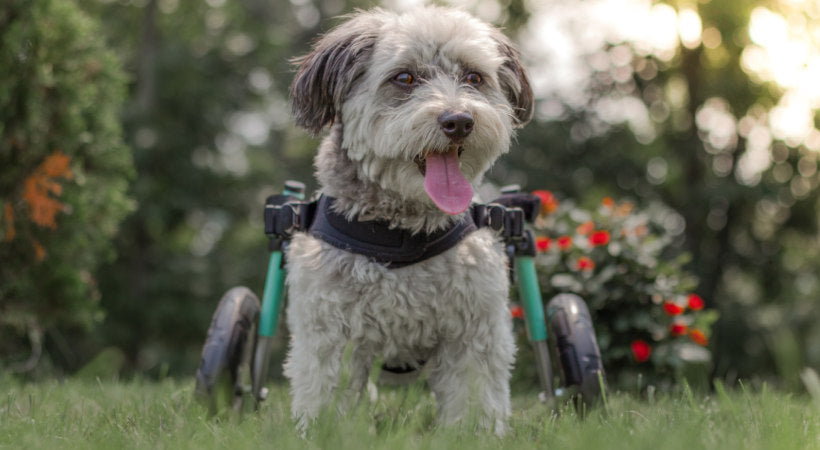Sit Down Dog Wheelchairs

7 Obedience Training Tips for Handicapped Dogs
Adopting a handicapped dog is a wonderful humane act. But it does not mean the dog is immune to societal expectations. Fortunately, you can take any dog, handicapped or not, through obedience training and achieve the first step of living in a human world.
Obedience training is an enriching activity. It will keep your furry buddy engaged and delighted. But, you will have to adopt a different approach - one that is suitable for his special needs. If your dog has a hearing impairment, is blind, or has a mobility disability, here are tips to help with obedience training.
Understand the Disability, the Limitations, and How to Communicate

Before you begin training, seek to learn more about the dog’s disability, what caused it and his limits. Just like human beings, disabilities in dogs arise due to various reasons. Some are born with disabilities. Other dogs' handicaps are due to congenital or contracted diseases or injury.
Getting a deeper understanding of the dog’s handicap will help you avoid pain points, set reasonable expectations, and communicate appropriately.
Fortunately, dogs communicate primarily through body language and sounds. They don’t have words. Thus, deaf dogs can quickly learn hand signals, and blind ones can easily tell the difference between different sound cues.
Plan for Regular Brief Training Sessions
Now that you know the limitations, the pain points, and how to communicate with the dog, plan the training sessions. Schedule regular but brief sessions so as not to overwhelm the dog. Handicap dogs should not be overexerted or overstimulated. It might exacerbate their physical or mental stress. Keep the sessions short and engaging. Two 15-20 minutes sessions in a day will achieve more than a single 30-minutes session.
Better still, mix up obedience training with playtime. But remember not to push the dog.
Use Both Hand and Sound Signals
Sign language or hand signals are excellent for a deaf dog. Sound cues are perfect for pets going blind. But, it is hard to tell the extent of the handicap, especially when it is due to age or ailment. In such cases combining both hand and sound signals could give better results. Besides, combining both visual and audio signals stimulates the dog’s mind and boosts his health.
Use Positive Affirmation

Whenever training a pet, especially a handicapped dog, positive affirmation gives better results than punishment. You want to teach the dog to associate obedience with good things. A hard stare, yelling, or even physical punishment will do the opposite.
Avoid crude methods of training like yelling, hard stares, or punishment. Instead, teach the dog a different cue to signal that he is responding in the wrong way. For example, you could wag your index finger while gently (and firmly) saying “uh-uh,” or “no,” and withhold the reward.
When the dog responds positively, reward him with a physical and verbal congratulation, like a thumbs up with a smile, and say great! Also, touch him and let him feel the joy in you. But don’t be too quick to give the treat. Only give treats after a couple of successes. Remember, a treat is like a salary. Let the dog work for it and wait for it. This way, it yields a better result.
Tools Can Help
Tools can go a long way in making the training more effective. For example, when training your blind dog to come to where you are, you can use a head collar or a head halter. It looks like a halo and is strapped around the dog’s snout. It can help a blind dog navigate new spaces by preventing him from bumping into barriers.
If your dog has a mobility challenge, use tools like dog carts or lifting harnesses can be used to help him get around without much pain.
Pay Attention to the Dog’s Signals
As you train your handicapped dog, be attentive to the way he responds. Sometimes the cues are not so obvious. They are subtle, and you might not pick them right away. So pay close attention so you can tweak the session accordingly. For instance, an old dog could hesitate to respond to the instruction to sit because the surface is hard. Change the location and try again. Keep doing this for all other commands and be observant.
Training Instruction to Prioritize
These tips will help you to nurture a great relationship with a handicapped dog and train him. But which obedience instructions should you prioritize?
Consider training your dog to do the following:
- Sit or down on command and stay put.
- Come only when called.
- Remain calm around another dog or pet, or when you’re grooming.
- Sit quietly beside a friendly stranger.
- Walk close to you on a loose lead.
- Maintain manners when under the care of a trusted person like a professional groomer.
Final Thoughts
To conclude, update the vet and dog behavior expert about how your dog responds to the obedience training. With the right kind of help, your dog, even though handicapped, will have fun learning these skills and enjoy living with people.









